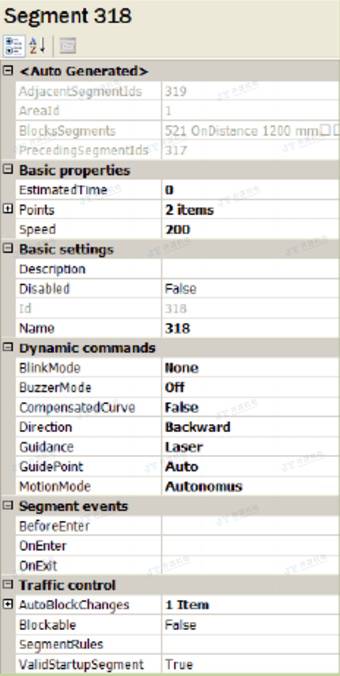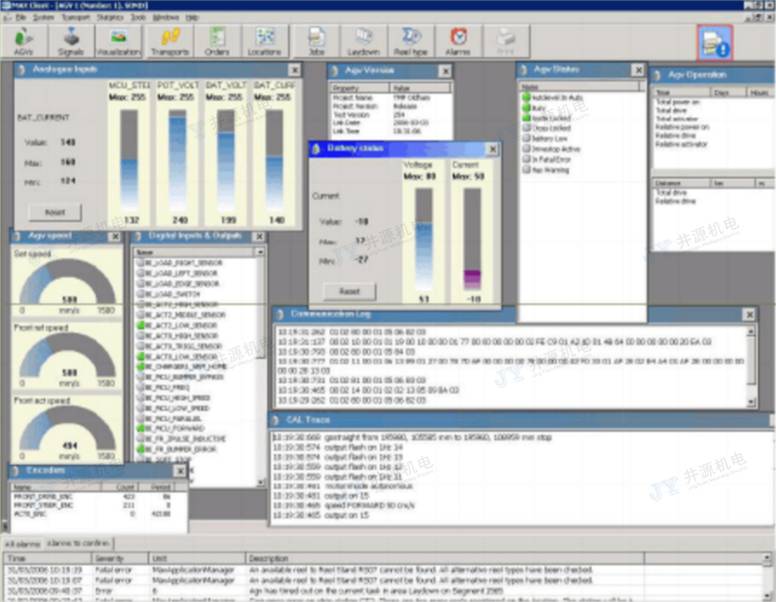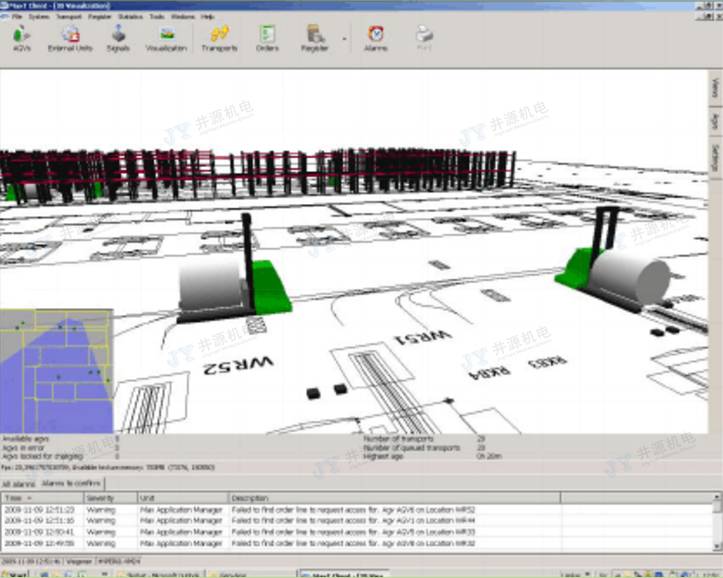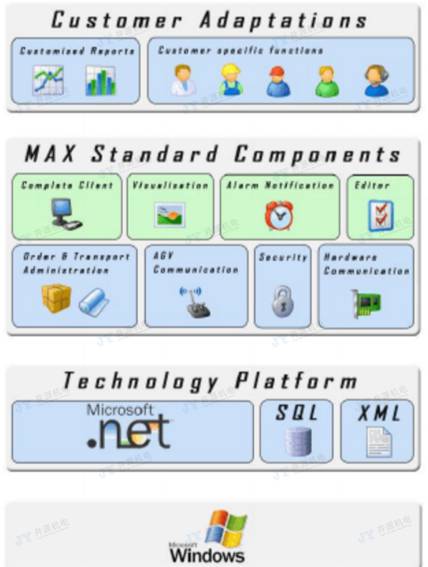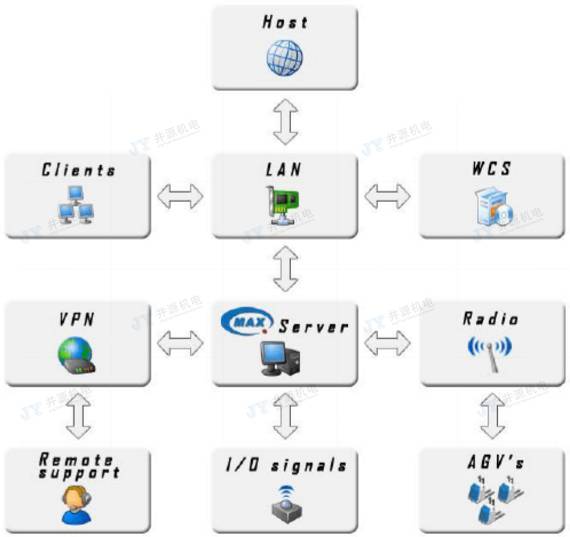MAX is the control system of the AGV trolley. According to the pre-set path, through buried line navigation or laser navigation, the trolley can be transferred and transported without manual control. It is widely used in many industrial fields.
AGV plays a very critical role in the field of automated material transportation, automatically loading, unloading and transporting. The function of today's AGV is not like the role of a taxi in the past. Technology and software from SoftDesign integrates automatic cranes, conveyor belts, shuttles, pallet stackers, warehouse management systems, etc. into a subsystem or a complete one-stop system. MAX ensures that the user's items are transported to the right place in the most efficient way at the right time, making the utilization rate of the AGV system reach 98%~100%.
MAX runs in a Windows environment, uses Microsoft technology, is easy to configure, is easy to expand and adjust when the production environment changes in the future, and is a reliable management system with state-of-the-art technology. Its user interface is equipped with a nice display, functional and easy to operate.
1 Advantages of the MAX System
1.1 Configurability
An important feature of any AGV system is the ability to configure the system to integrate with the customer's production environment. When the production environment changes, the AGV system must be able to change accordingly to meet production needs.
In MAX, all system configuration is done with 3D visualization through the MAX editor. Transportation, warehousing, tracking, buffering, task switching, dynamic routing, site selection, charging control, task prioritization, deadlock avoidance, all in real-time 3D visualization. This allows the user to configure all parts of the system, from the location and operation of the pickup and storage points to the name of the individual AGV.
On the MAX editor the user can see the layout of the system and all the components in the system. You can use scrolling, zooming, etc. to see the smallest details in the system. All objects in the system such as navigation paths, charging stations or AGVs can be edited. When an object is clicked, the object is displayed in the MAX editor pane, so that the user can edit any object in the system as desired. The MAX Editor is a powerful yet easy-to-use configuration tool.
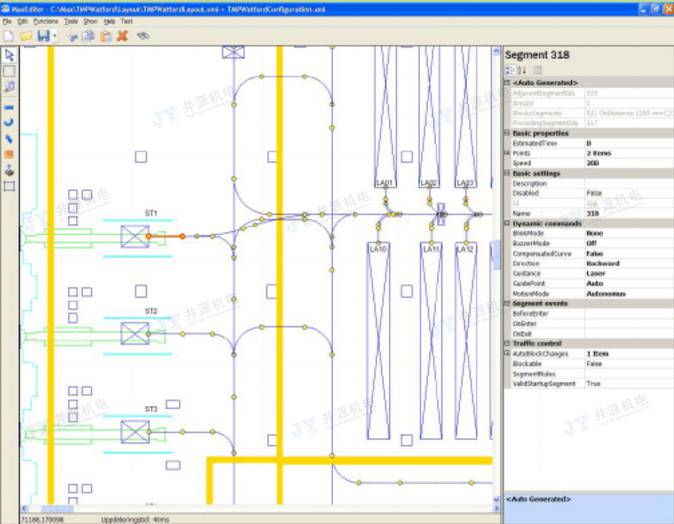
Figure 1: MAX editor screen
Figure 2: MAX editor performance table
1.2 Scalability
MAX supports the simultaneous use of different technologies, supports the simultaneous use of AGV technologies of different generations, supports the simultaneous use of different types of AGVs and bearer equipment, and can be configured through MAX to prevent specific AGVs from entering certain areas.
Therefore, if the user decides to expand the production line in another place, there is no need to buy another AGV system. One MAX management system can manage and control several different production layouts at the same time. Also, existing layouts can easily be adjusted or extended, such as adding new equipment or AGVs. With the development of technology, new and better hardware will appear. If you want to expand the existing AGV platform or technology, MAX can do it.
1.3 Accessibility
An AGV system needs to be operated by the user to function. Multiple users in different places can manage the AGV system according to their own requirements and computer level.
The MAX client is installed on a computer at any site, runs in a Microsoft Windows environment, and has a graphical user interface that allows users to manage all functions of the AGV system. As long as the user has experience operating Windows, it is easy to learn how to operate the MAX client.
The MAX client provides users with a real-time overview of the system, which can be automatically updated at any time. Users can open many functions at the same time according to their needs, and can meet their own needs through Windows applications. When the user logs in the next time, what they see is the layout set according to their needs. The MAX client also allows users to choose their preferred language.
Figure 3: MAX client AGV diagnosis
Figure 4: 3D view of the MAX client
In addition to the MAX client, there are also displays on the AGV to provide information to the user, such as where the AGV is going, what it is doing now, why the AGV has stopped, etc. Customers can also choose the language according to their preferences.
1.4 Stability
When users have new ideas for the production environment, don't worry, MAX is easy to expand with new functions. MAX can do many different configurations. System stability is ensured as the applications use the same platform technology and components.
.Net is a modern, robust, and extensible platform that has become the standard in the software development industry. XML provides a powerful and flexible platform-independent configuration and integration method. SQL is a widely used easy-to-understand database language. These technologies, along with the Microsoft Windows operating system, are well known in the IT industry.
Figure 5: Design diagram of the MAX system
2 Typical configuration of MAX system
2.1 Communication medium
In any AGV system, the MAX needs to be controlled and communicated with many hardware technologies through different communication mediums. MAX supports communication with AGVs using broadcast and wireless network communications. Another feature is the I/O signal exchange between hardware devices to provide MAX current status of photocells, fire doors and emergency stop buttons.
2.2 Communication module
Often the user already has a mainframe system, a production system or a warehouse management system. In this case, these systems can provide production planning or direct shipping tasks to the MAX via custom communication modules. Can also be extended on MAX, because MAX is an open interface.
2.3 Remote Support
Remote support is critical, allowing the MAX system to be remotely controlled or monitored from any computer connected to the user's network. SoftDesign uses virtual private network technology, uses the Internet as a communication medium, and can also directly connect with Modem.
2.4 Platform Technology
The quality of any software system depends on the platform technology it uses, and the platform technology determines the robustness and flexibility when the system is adjusted or upgraded. SoftDesign chose Microsoft products as the standard.
Figure 6: Typical configuration of a MAX system
3 Functions and technical characteristics of the MAX system
3.1 MAX's data & reporting function
3.1.1 MAX's data function is a powerful information tool that continuously and accurately stores production information to find answers to the following key questions:
●What equipment problems occurred in the last month?
●AGV performance data?
●How about the AGV utilization rate in the system? Do you need to expand your system?
●What is the average time to complete a transport task? How long will the production equipment take?
●What alerts have occurred in the past 24 hours? When was the last special alert?
●How many shipping tasks were completed in the past year/month/week?
The data of MAX can also be adjusted according to the needs of customers, and the information can also be exported from the system and used in the company report in the form of Excel.
3.1.2 When something very important happens in the AGV system, MAX will notify the user in the following ways:
●All information will be displayed on the MAX client software. If IT support or hardware engineers need to be contacted, MAX can provide them with some initial information remotely. Each system alert or critical event can be configured to be sent to multiple different recipients.
●Some specific errors in the system can be sent to the pager or in the form of a short message.
●Relatively unimportant errors will only be seen on the LAN screen.
●When the transportation task to a specific site is completed, the electronic components can be sent to the production department of the local area network.
●System errors or problems can be automatically sent to the support system.
3.2 Integration with Windows to ensure user security
3.2.1 Integration with Windows Security System
●Easy management.
●Existing network security guarantees can still be used.
●Users only need to remember their login information.
3.2.2 Configurable user levels
●The user can only have the rights assigned to him.
●Can also have full rights.
3.2.3 Traceability
●Important events will be recorded in the log, which is easy to find.
●It can realize the tracking report of AGV, equipment and users.
3.3 System Maintenance and Management
3.3.1 Maintenance of AGV
●AGV will be dispatched to charging station or maintenance station.
●The log of AGV operation can be managed through MAX.
●MAX provides a standard for all AGVs in the system: the integrated tool MAX Diagnostics.
3.3.2 System Maintenance
●MAX's self-maintenance function will automatically archive old data, one in the hard disk and one in the database.
●Requires little maintenance.
●The installation of the new version of the client is realized through a server, and the user will receive the new version when logging in next time.
3.3.3 Quick restart
●When performing system maintenance or reconfiguration, it may be necessary to restart the system.
●The system restart time is less than 1 minute (from system stop to system fully running).
●System restart will not affect AGVs. After restarting, the system will automatically continue the previous task.
3.4 AGV controller used by MAX system - SONIX
MAX uses SONIX as the controller of the AGV, which is highly flexible. SONIX is a standard AGV controller from SoftDesign that can control all different types of AGVs. The SONIX controller is the main component in the AGV, monitoring and controlling all parts of the AGV. The SONIX area uses standard components, is built on the basis of PC104, and performs tasks together with the operating system Linux. SONIX has the following features:
3.4.1 Security
●SONIX ensures that AGVs are operating safely
●SONIX controls the action or stop of the AGV. If the AGV stops or decelerates due to receiving information from the buffer, emergency button, and code reader, SONIX will report it to the system.
3.4.2 Flexibility
●SONIX is compatible with all AGV types, such as single steering wheel AGV, dual steering wheel AGV or multi-function AGV.
●SONIX is compatible with buried wire navigation and the most commonly used laser navigation.
3.4.3 Overview
●SONIX stores all AGV information, such as battery condition, driving time, AGV parameters, etc. These information can be displayed on the AGV display.
●MAX Diagnostics: An easy and time-saving feature that can be used to service, maintain, or find the source of a problem, either through the MAX client or alone on the shop floor.

